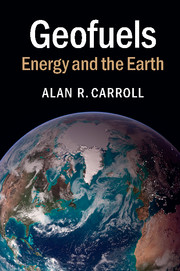Book contents
- Frontmatter
- Contents
- Acknowledgments
- 1 Introduction
- 2 The Living Earth
- 3 Warmed from Above: Solar Energy
- 4 Wind, Water, and Waves: Energy from the Fluid Earth
- 5 Covered in Green: Biofuels Basics
- 6 Fossil Farming: The Geologic Underpinnings of Biofuels
- 7 The Light of an Ancient Sun: Fossil Fuel Origins
- 8 Digging for Daylight: Coal and Oil Shale
- 9 Skimming the Cream: Conventional Oil and Gas
- 10 Stuck in the Mud: Fossil Fuels That Fail to Flow
- 11 Petrified Petroleum: Oil Sand and Gas Hydrate
- 12 Water, Water, Everywhere
- 13 Primordial Power: Geothermal and Nuclear
- 14 Out of Sight, Out of Mind: Geologic Waste Disposal
- 15 How Long Is Forever? Energy and Time
- 16 Conclusions
- Index
- References
9 - Skimming the Cream: Conventional Oil and Gas
Published online by Cambridge University Press: 05 March 2015
- Frontmatter
- Contents
- Acknowledgments
- 1 Introduction
- 2 The Living Earth
- 3 Warmed from Above: Solar Energy
- 4 Wind, Water, and Waves: Energy from the Fluid Earth
- 5 Covered in Green: Biofuels Basics
- 6 Fossil Farming: The Geologic Underpinnings of Biofuels
- 7 The Light of an Ancient Sun: Fossil Fuel Origins
- 8 Digging for Daylight: Coal and Oil Shale
- 9 Skimming the Cream: Conventional Oil and Gas
- 10 Stuck in the Mud: Fossil Fuels That Fail to Flow
- 11 Petrified Petroleum: Oil Sand and Gas Hydrate
- 12 Water, Water, Everywhere
- 13 Primordial Power: Geothermal and Nuclear
- 14 Out of Sight, Out of Mind: Geologic Waste Disposal
- 15 How Long Is Forever? Energy and Time
- 16 Conclusions
- Index
- References
Summary
Petroleum has of late years become the matter of a most extensive trade, and has even been proposed by American inventors for use in marine steam-engine boilers. It is undoubtedly superior to coal for many purposes, and is capable of replacing it.
William Stanley Jevons, 1865Perhaps the most iconic image of the bounty of fossil fuels was the well drilled at Spindletop Hill in east Texas, which began to gush oil in the opening days of the 20th century (January 10, 1901; Figure 9.1). Oil spewed more than 150 feet in the air, at an initial rate estimated at approximately 100,000 barrels per day. This flow rate translates to a power output of about 6 gigawatts, roughly equivalent to the rated capacity of three Hoover Dams (power is defined as the rate at which energy is transferred). Remarkably, the liberation of this staggering energy resource only required drilling 1,139 feet into the Earth, a depth less than that of many municipal water wells. Once unleashed, it took nine days to bring the gusher under control. With such immense power waiting literally to leap from the ground, it is small wonder that oil went on to reshape the world.
Uncontrolled eruptions of oil like the one at Spindletop are of course hugely wasteful and pose great danger due to their flammability and to the contamination of the surrounding area. The petroleum industry and government regulators therefore go to great lengths to prevent such catastrophes, which have ironically become all the more shocking for their rarity. The fundamental geologic truth of conventional oil fields remains unchanged more than a century after Spindletop. All such accumulations comprise fluid hydrocarbons that have been highly concentrated by natural geologic processes. These concentrated fluid accumulations lend themselves to comparatively easy (and controlled) extraction, encouraging an analogy to the cream that can be skimmed from the top of a pail of raw milk.
- Type
- Chapter
- Information
- GeofuelsEnergy and the Earth, pp. 165 - 188Publisher: Cambridge University PressPrint publication year: 2015



